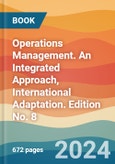Operations Management: An Integrated Approach, 8th edition, provides a solid foundation of the subject with clear, guided instructions and a balance between quantitative and qualitative concepts, thus providing both an applied and practical approach. In addition to leveraging customizable, tactile teaching and learning methods, the text covers emerging topics like artificial intelligence, robotics, data analytics, and sustainability.
This international edition includes several revisions and additions to the content, including updated company examples across all chapters, updated discussions with regard to the latest technologies that impact operations and supply chain management, and revised problems in all chapters. In addition, the edition includes a new “Pandemic Effects” box that addresses how the chapter topic has evolved or changed during the COVID-19 pandemic and how it is evolving in a post-pandemic environment.
Table of Contents
1 Introduction to Operations Management 1
2 Operations Strategy and Competitiveness 26
3 Product Design and Process Selection 51
4 Supply Chain Management 92
5 Total Quality Management 141
6 Statistical Quality Control 173
7 Just-in-Time and Lean Systems 219
8 Forecasting 251
9 Capacity Planning and Facility Location 298
10 Facility Layout 336
11 Work System Design 371
Supplement A Spreadsheet Modeling: An Introduction A- 1
Supplement B Introduction to Optimization B- 1
Supplement C Waiting Line Models C- 1
Supplement D Master Scheduling and Rough-Cut Capacity Planning D- 1
12 Inventory Management 408
13 Aggregate Planning 458
14 Resource Planning 492
15 Scheduling 529
16 Project Management 563
Appendix A The Standard Normal Distribution 597
Appendix B p-Chart 599
Answers to Odd Numbered Problems 604
Company Index 630
Subject Index 632








